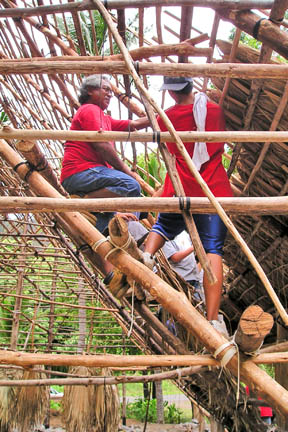

|
Project houses Hawaiian
culture
Maui students build a traditional
hale under modern guidelines
IAO, Maui » Maui High School students tie palm fronds to the A-frame of a traditional Hawaiian house at the state's Kepaniwai Park in Iao Valley in a hands-on class that teaches them about native culture.
"Not too wide. I'd rather have the palms too close than too far," said master builder Francis "Palani" Sinenci, who has helped to build more than 60 native Hawaiian structures.
The construction project, sponsored by the county and state, involves the building of a Hawaiian "hale halawai," or gathering house, to replace a "hale noho," or sleeping house, burned down a couple of years ago.
Sinenci, who is volunteering his labor and expertise, point out that the hale is being constructed according to rules adopted on May 7 by the county Department of Public Works and Environmental Management establishing standards for indigenous Hawaiian architecture.
The rules, mandated by the Maui County Council, include limits on the size of the hale, materials to be used in making them and when a fire sprinkler system is required in the structure.
Similar rules are being developed by the City and County of Honolulu's Department of Planning and Permitting, following the adoption in July of an indigenous architectural ordinance on Oahu.
Rather than using traditional sennit, students are knotting the fronds onto the structure with nylon parachute cords because of their proven strength and resilience, he said.
Because of the lack of affordable native hardwood, some non-native trees such as ironwood and inkberry are used in the structure, but the wall posts are made of native ohia, he said.
During a day-long workshop Monday, the 19 students from a Hawaiian studies class at Maui High helped in gathering the palms from a storage shed and taking turns tying the palms on the 30-by-40-foot hale.
"It's good because you learn more of the Hawaiian culture," said Paulo Samita Jr., a freshman.
Hawaiian studies teacher Kailani Ross said the students learned about indigenous plants, the names of various posts in a traditional hale and the cultural protocols in preparing to erect a native structure.
Ross said eventually the Hawaiian studies class would like to build a hale on the school grounds and is looking for funding sources.
Several years ago, erecting a traditional Hawaiian hale would have been difficult because the county building code on Maui was based on using Western techniques and materials.
But county ordinance and rules now allow the use of native woods and other materials within limits and have established a way for the traditional hale to be built by a new generation of master builders.
Sinenci, who has taught a course on traditional Hawaiian hale construction at Maui Community College, has trained 10 master builders, including one from Oahu and another from Kauai.
At the Iao hale site, apprentice Prescott "Kepa" Guillermo hopes to become the 11th.
Guillermo, who has worked as a certified arborist and tree trimmer, said he has enjoyed the experience since he started the apprenticeship in July. "I'm learning my roots," he said. "It's a great privilege."